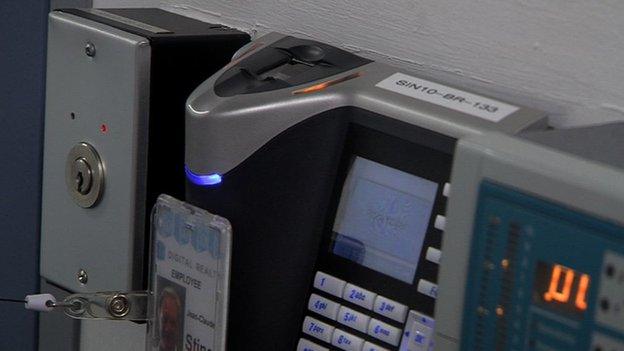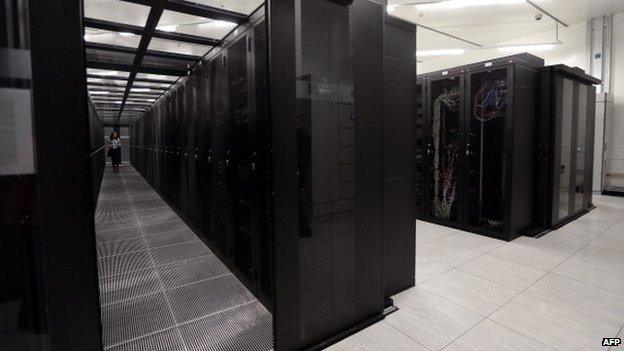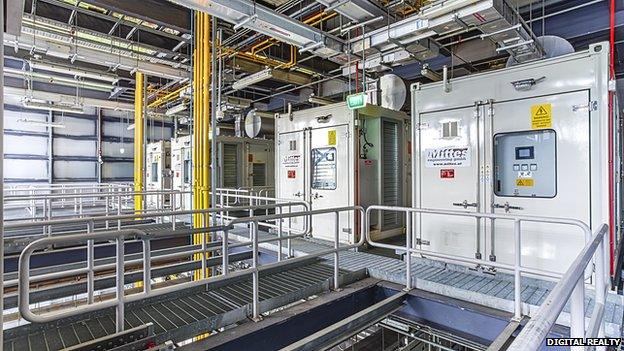Inside a custom-built data centre
- Published
As more and more people in Asia take to the internet to do their everyday tasks like banking and shopping, the demand for secure facilities to house the information is growing.
As I stepped inside the first layer of the fortress-like building, the first thought that came into my mind was: "Thank God I am not claustrophobic."
With just enough room for one person to stand, the circular glass enclosure - designed to ensure that no-one can "tailgate" another person - is one of the many levels of security that you have to go through to get beyond the reception area of the building.
But then again, it was no ordinary building that I was about to enter.
Welcome to the world of what can aptly be called digital fortresses - custom-built buildings that house data centres.
'Mission critical'
The BBC was given access to one such centre in Singapore, built by Digital Realty, a firm that specialises in constructing such facilities.
From bomb-blast resistant areas to biometric security scanners, these specially designed buildings are fast becoming a preferred choice among companies looking to set up data centres.
The reason is simple.

Many data centres use biometric security scanners to control access to the facilities
Firms are storing an ever-increasing amount of data about their customers as the use of technology becomes an indispensible part of people's lives.
From sending text messages, using online shopping portals, making travel bookings, to carrying out banking transactions online - more and more people are using technology to carry out everyday tasks.
And all the data generated by using these services needs to be stored in a safe and secure environment. Equally important is uninterrupted access to this data for both the companies and the users.
"Data centres are mission critical facilities for firms. A failure on this front can have disastrous consequences, especially if you are a large enterprise," Andrew Milroy, an analyst with consulting firm Frost & Sullivan, tells the BBC.
Singapore's rules
Among the companies that rely on data centres, arguably the most important ones are financial institutions such as banks.

Data centres usually see hundreds of servers stacked together, which generates a huge amount of heat
Uninterrupted access to data is key to them being able to offer even the most basic of services such as withdrawing money from an ATM machine.
Singapore's central bank, the Monetary Authority of Singapore (MAS), has put stringent rules in place, external for financial firms when it comes to their data centre buildings.
These include making parts of the building that are exposed to pedestrian and truck traffic bomb-blast proof and having metal detectors at the facility.
Kris Kumar, the Asia-Pacific head of Digital Realty, says policymakers across the globe are looking to ensure that critical sectors are safeguarded properly.
"Technology, especially that which caters to financial services, is being looked upon as national infrastructure," he says.
"It is critical not just to the company and its users but also to the country's economy."

An adequate back-up of power supply is key to ensure the smooth running of data centre facilities
Tailor made
Equinix, another firm specialising in such buildings, is constructing a new facility in Singapore.
Apart from the enhanced security requirements for the financial institutions, even the most basic infrastructure needs to be tailored to suit the needs of such buildings.
The two most important and critical components are electricity and water supply. The servers not only need uninterrupted power supply - but also consume far more electricity that normal computers.
.jpg)
Various security measures restrict access to Digital Realty's facility in Singapore
The amount of power delivered to a data centre is nearly 10 times what a normal office building would use.
Digital Reality's facility in Singapore has two alternative sources of power to ensure constant supply. As a back-up, it has put in place 28 generators spread across seven floors - good enough to power 15,000 homes for two days.
Keeping cool
Data centres also generate a large amount of heat - which means the buildings need to be designed to keep the temperature in check.
If the servers overheat, it can result in "thermal failure". And just putting high-powered air-conditioning in is not enough to avoid that.
Digital Realty's facility in Singapore uses "precision cooling units" that blow cold air from openings in the floor to "extract" the heat generated by the servers.
The warm air is then channelled through a cooling unit - to bring its temperature down - and sent back to the server room through the floor again.
"This cycle has to be continued. If it is interrupted the temperature of the servers will reach a critical point," says Mr Kumar.
Ajit Melarkode, managing director of Rackspace Asia Pacific, a cloud computing provider, says that uninterrupted power supply and proper cooling systems are key factors his firm looks at when deciding where to house its servers.
"We need to be sure that our systems will keep running smoothly," he tells the BBC.
"In today's world, uninterrupted connectivity has become a basic requirement."